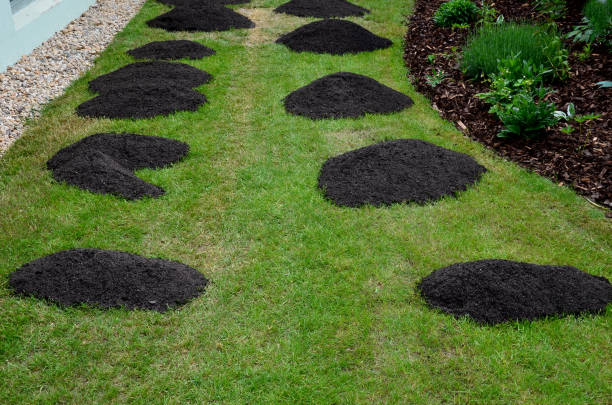Mulch installation is an essential part of landscaping and gardening that involves spreading a layer of organic or inorganic material over the soil to provide various benefits. Mulch can help retain moisture, suppress weeds, regulate soil temperature, and enhance soil fertility. However, installing mulch can be a time-consuming and labor-intensive task, especially for large areas. That’s where mulch installation services come in. These services offer professional assistance in spreading mulch efficiently and effectively, saving homeowners and gardeners time and effort.

Benefits of using mulch in your landscaping
Mulching is one of the best things you can do for your landscaping. Here are some benefits of using mulch:
- Improves Soil Health – Mulch protects the soil from erosion and reduces weed growth. Over time, it decomposes, adding nutrients back into the soil.
- Conserves Water – Mulch helps to retain moisture in the soil by reducing evaporation, thus allowing plants to stay hydrated during dry periods.
- Controls Temperature – Mulch acts as an insulating layer, keeping the soil cool in summer and warm in winter. This provides ideal conditions for plant growth.
- Enhances Aesthetic Appeal – Mulch can instantly enhance the look of your landscape by providing a uniform color and texture to the garden beds.
- Reduces Maintenance Time – Mulch reduces the need for frequent watering and weeding, which means less time spent on maintenance tasks.
- Protects Plant Roots – The layer of mulch provides a protective barrier for the roots of plants, preventing damage from extreme temperatures and pests.
- Encourages Beneficial Creatures – Mulch creates an ideal environment for beneficial insects, worms, and microbes that can help improve soil health and support plant
How to choose the right type of mulch for your yard?
Choosing the right type of mulch for your yard depends on several factors such as the climate, soil type, and personal preferences. Here are some tips to help you choose the right mulch:
- Consider the Purpose – Think about why you need or want to use mulch. Is it to enhance the appearance of your landscape, improve soil health, conserve water, or control temperature? This will guide you in selecting the right type of mulch.
- Check Local Availability – Look for mulch options that are readily available in your local area as they tend to be more affordable and better suited to the local climate and soil conditions.
- Assess Soil Type – Consider the type of soil in your garden beds. If you have clay soil that tends to hold water, choose a mulch that allows for good drainage such as gravel or pine needles. For sandy soil that quickly dries out, opt for a heavier mulch like wood chips or straw to help retain moisture.
- Evaluate Climate – Look at the weather patterns in your area and choose a mulch that can withstand harsh weather conditions. For areas with hot summers, choose a mulch that can reflect sunlight and keep the soil cool .
Mulching is a vital practice for any gardener as it offers numerous benefits to the plants. One of its most significant advantages is that mulch provides a protective barrier against extreme temperatures and pests, which can damage roots. Additionally, mulching encourages beneficial creatures such as worms, insects, and microbes that help improve soil health and support plant growth.
Importance of proper installation techniques
Proper installation of mulch is essential to ensure that it offers maximum benefits to your garden. Here are some tips on how to install mulch correctly:
- Apply the right amount – Too much mulch can suffocate plant roots, while too little may not provide adequate protection. A layer of 2-3 inches is usually sufficient.
- Keep the mulch away from plant stems – Direct contact between the mulch and plant stems can lead to rot and other diseases. Leave a small space around the stem free of mulch.
- Water the area before applying – Moist soil helps the mulch settle in and stay in place. Apply the mulch to damp soil, and water it again after installation.
Choosing the right type of mulch is also crucial for optimal plant growth. Consider factors such as the type of soil in your garden beds and the climate in your area when selecting a mulch. For clay soil, choose a mulch that provides good drainage, such as gravel or pine needles. For sandy soil that quickly dries out, opt for a heavier mulch like wood chips or straw to help retain moisture. In areas with hot summers, select a reflective mulch
How to prepare your yard for mulch installation ?
Before installing mulch in your yard, there are a few essential preparation steps you should follow to ensure optimal plant growth and maximum benefits from the mulch.
- Clear the area – Remove any weeds, rocks, or debris from the garden beds where you plan to install mulch.
- Prune plants – Trim back any overgrown branches or foliage to allow for better air circulation and sunlight penetration.
- Fertilize the soil – Apply a slow-release fertilizer to the soil before installing the mulch to provide adequate nutrients for plant growth.
- Install edging – Use edging materials

Conclusion
Regularly check and replenish the mulch as needed Mulching is an essential part of landscaping that offers a range of benefits to your yard. It helps protect and enrich the soil, retain moisture, prevent weed growth, regulate soil temperature, and enhance the appearance of your lawn and garden. However, choosing the right type of mulch for your yard is crucial to ensure optimal results.
When selecting mulch for your property, consider factors such as the texture, color, durability, and nutrient content. You’ll also need to install it correctly to ensure maximum effectiveness. Improper installation can lead to issues such as mold growth or damage to plants.
For best mulch services contact Soil and Seed Landscaping.

